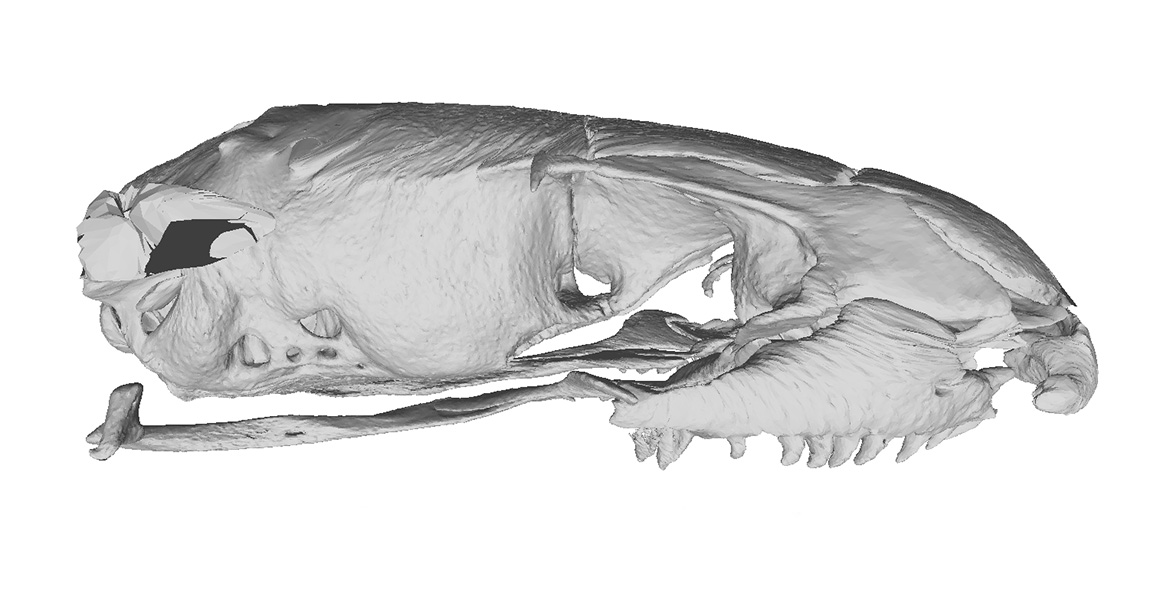Researchers have reconstructed the ancestral snake head.

A reconstruction of the ancestral snake skull
It is part of a larger project to create 3D reconstructions of how the skull evolved.
Snakes and lizards (squamates) are part of a diverse group that includes burrowing snakes, gliding lizards and climbing chameleons. The animals in this group live all over the world in a huge variety of habitats, which means they all have very different skull shapes.
Comparing all their skull shapes wasn't an easy task - there are few points of obvious comparison - but a team of researchers have succeeded. Scientists from the UK, USA, Germany and France used cutting-edge imaging techniques and hundreds of specimens from both extinct and living species.
Prof Anjali Goswami, research leader at the Museum, explains, 'We capture lots of surface landmarks across the bones to get a better 3D picture of the animal's skull.
'CT scanning and laser scanning in the Museum's Imaging and Analysis Centre are making this possible. The Museum is one of the best places in the world for these types of facilities, and it is shaping how science can be done differently.
'Once we have this nice dataset with 1,000 or more data points across the skull, we use various methods and computer programmes to examine how skull shape has changed through time.'
Akinobu Watanabe, Assistant Professor at New York Institute of Technology, who led the study, adds, ‘We used and developed brand new tools to collect and analyze this high-density skull dataset.
'This allowed us to reveal the evolutionary journey of how differences in the skull architecture of lizards and snakes arose from their common ancestors at an unprecedented scale and resolution.’
There are several questions the team wanted to answer: are some snakes and lizards evolving faster than others? Do you evolve faster if you live in water or underground? If one part of a skull evolves, do others evolve too?
The international team of collaborators found that plant-eating squamates generally evolve faster, and that snakes that spend time in the water or underground were also quick evolvers.
Incredibly, the team were able to delve so far into snake evolution that they could reconstruct the likely ancestral snake.
Surprisingly, the study points to the common ancestor being semi-fossorial, meaning it spent some of its life both above and underground and not in an aquatic environment, a habitat that was previously thought to have encouraged the evolution of the snake’s long thin body and unusual method of locomotion.
Prof Goswami says, ‘There is a lot of debate about how snakes evolved, but we think we have traced the ancestral skull shape. Lots of scientists have speculated that maybe snake ancestors lived in water, which made them lose their legs. So it’s surprising that the patterns we saw led us to a semi-fossorial animal.’
More than 170 digitised specimens were used for the project. They are now available to download for free as part of the Phenome10k project.
The study is by far the biggest of its kind ever completed.
Anjali adds, 'Truly open data is now becoming a reality, but it wasn't when we first started this project.
'This study is also a great example of the benefits of digitised specimens. There is a big push to digitise Museum specimens, but we are still working out what we can achieve with all the data.
'This is a high-density approach that we have been developing, and it means you can get more information about skull shape than you ever could before.'
Further reading
- Read the paper in the journal PNAS.
- Explore the Phenome10k project.
- Read about Anjali’s recent paper on bird skull evolution.
- Discover the Museum's digital collections programme.
Don't miss a thing
Receive email updates about our news, science, exhibitions, events, products, services and fundraising activities. We may occasionally include third-party content from our corporate partners and other museums. We will not share your personal details with these third parties. You must be over the age of 13. Privacy notice.
Follow us on social media